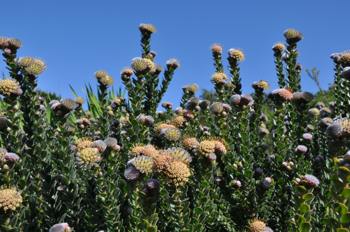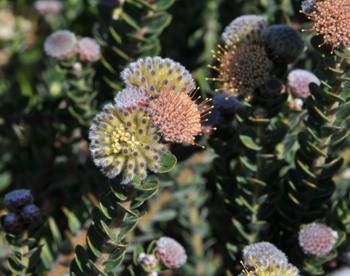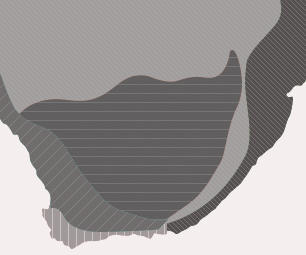Leucospermum truncatulum
Leucospermum truncatulum (Salisb. ex Knight) Rourke
Family: Proteaceae
Common names: oval-leaf pincushion, buxifolium, buxi (Eng.); patrysbos, kleinkopspeldekussing (Afr.) (= L. buxifolium R.Br.)
Introduction
Leucospermum truncatulum provides form, texture and colour to the garden, with its upright stems that are neatly covered in rounded leaves, and clusters of soft yellow, pinkish and orange pincushions during winter, spring and early summer.

Description
Description
Leucospermum truncatulum is a slender, sparsely branched shrub with stiffly erect stems to 2 m high and a single main stem. The leaves are small (10-25 mm long and 5-10 mm wide), egg-shaped, with the narrower part nearer the base of the leaf, to nearly circular (obovate to orbicular), densely covered with short hairs and with an entire margin. The leaves densely cover the stems, like overlapping tiles on a roof (imbricate).

The flowerheads are nearly spherical, small (15-20 mm in diameter), with no stalk (sessile) and usually in clusters of 2-8 heads per flowering stem. The flowerheads start off as silvery white and densely hairy. They are yellow when fresh and newly open, becoming pinkish and crimson with age. The individual flowers are yellow and age pinkish. The styles start out yellow and age to orange and keep their yellow tips (which are called pollen presenters) but end up quite a dark reddish orange. The flowers open from the centre of the flowerhead outwards. Leucospermum truncatulum flowers during winter, spring and early summer (August to December).
Conservation Status
Status
Near Threatened. The wild population of Leucospermum truncatulum has declined by nearly 30% because it has lost 27% of its habitat, mainly to agriculture, in the past 60 years. Although most populations are in sites safe from agriculture, the population continues to show a declining trend, due to invasive alien plants like Australian acacias, hakeas and pines invading its habitat, flower picking which damages plants and reduces the seed bank, and to protea cultivation damaging its habitat.
Distribution and habitat
Distribution description
Leucospermum truncatulum grows in sandstone fynbos on sandy flats and slopes to 400 m altitude from the eastern foothills of Kogelberg Peak and southwards through Kleinmond, Bot River, Groenland and Klein Rivier Mountains, Caledon Swartberg, Elim Flats, Soetanysberg, Bredasdorp Mountains, to just north of Cape Agulhas. It is a social species, forming dense stands over large areas. It favours south- and east-facing slopes.

Derivation of name and historical aspects
History
The genus Leucospermum is named from the Greek leukos meaning white, and sperma seed, referring to the white or light -coloured seeds of many species. The specific name means somewhat cut off, but it is unclear exactly what is somewhat truncated. The specific epithet of the synonym L. buxifolium means with leaves like Buxus, the box plant.
This species was named truncatulum by Salisbury in 1809 and buxifolium by Brown in 1810. Since Salisbury published first, his name is the valid one, but Salisbury's was ignored and Brown's was in use for many years until the rules of priority in naming plants was enforced. In the cut-flower trade, it is still called and traded as buxifolium or buxifolia.
Its Afrikaans common name patrysbos, meaning 'partridge bush' or 'francolin bush', refers either to the liking that francolin have for the seeds, or because they are seen sheltering underneath them during the hottest part of the day.
Ecology
Ecology
Leucospermum truncatulum is pollinated by insects, such as bees and flies. The seeds are dispersed by ants. There is a fleshy coating on the seeds, called an elaiosome, that attracts ants. The seeds fall from the flowerheads when ripe, and ants carry them away to their nests where they consume the elaiosome, but do not harm the seeds. In this way the seeds are dispersed and stored safely underground. This is known as myrmecochory. The plants are killed by fire, but afterwards, the seeds in the ant nests germinate to regenerate the population.
Uses
Use
Leucospermum truncatulum has been used and sold as a 'green' in the cut-flower trade for many years. It is not well known as a garden plant, and in comparison with some of its superbly showy relatives, its flowerheads, although multi-coloured, are muted. Nevertheless, its neat foliage and upright habit, and softly coloured flowerheads, make it an interesting and unusual choice for the garden.

Growing Leucospermum truncatulum
Grow
Grow Leucospermum truncatulum in a sunny position in well-drained, sandy, acidic soil. Pinching out the tips on young plants will result in a fuller, well-branched specimen, but left to its own devices it can get a bit leggy. Planting 3 to 5 plants close enough to grow together will result in what looks like a single but fuller bush. This species also looks good mass-planted.
Like most members of the Protea family, Leucospermum truncatulum is adapted to nutrient-poor soils and has fine and sensitive roots that cannot cope with strong fertilisers. Feed with diluted liquid fertiliser or low doses of general fertiliser, or slow-release fertiliser, and mulch generously and frequently with well-rotted compost. Avoid manure. L. truncatulum will tolerate summer drought, but performs best with a good weekly watering throughout the year. It is also wind tolerant and should survive outdoors in zone 9 (-7 to -1° C; 20 to 30° F).
Leucospermum truncatulum is well suited to the fynbos garden, gardens on sandy flats and coastal gardens. It is also suitable for Mediterranean gardens, and the shrubbery, rockery, slopes and terraces in non-fynbos gardens, and summer-rainfall gardens, provided the soil is well-drained, not alkaline, and the site is not still and humid. Leucospermum truncatulum is relatively fast-growing, flowering in its third year from seed.
Propagate Leucospermum truncatulum by seed or cuttings. Sow seed in late summer to autumn (end of February, March or April). Seeds need alternating cold night and warm day temperatures of 4-10° C to 15-20° C to trigger germination. Such temperatures are typical of autumn in the Western Cape and indicate the start of the rainy season. Use a well-drained medium, e.g. two parts coarse sand to one part leaf mould or fine-milled pine bark and one part loam. Cover the seeds with coarse, clean sand or fine-milled bark and keep warm and moist.
Germination will be dramatically improved if the seeds are soaked in a 1% solution of hydrogen peroxide for 24 hours. This oxygenates the seed and softens and loosens the seed coat, which should be rubbed off. Treatment with Instant Smoke Plus Seed Primer will also enhance germination - the two treatments can be applied simultaneously. Watering the seed tray with a fungicide will prevent fungal disease. Germination occurs in 3-4 weeks and the young seedlings are ready to be potted up as soon as they have developed their first set of true leaves. Use a sandy, well-drained, acidic soil mix suitable for fynbos and place them in a lightly shaded, well ventilated area. Seedlings are best planted into the garden when at least one year old.
Take semi-hardwood tip cuttings or heel cuttings from the current season's growth in summer-autumn (Dec.-March). Choose vigorous, disease-free material. Treat with rooting hormone and place in a well-drained medium and place in a mist unit on a bench with bottom heat of 24°C. Good air circulation is required to prevent fungal infection. Leucospermum truncatulum roots easily in about five weeks, and the rooted cuttings should be hardened off for three weeks before being potted. Use a sandy, well-drained, acidic soil mix suitable for fynbos and grow on for at least a year before planting out.
Acknowledgments: Louise Nurrish for sharing her experience in growing Leucospermum truncatulum.
References
- Goldblatt, P. & Manning, J. 2000. Cape plants. A conspectus of the Cape Flora of South Africa. Strelitzia 9. National Botanical Institute, Pretoria & Missouri Botanical Garden Press, Missouri.
- Plants of southern Africa: an online checklist. http://posa.sanbi.org
- Protea Atlas Project. http://protea.worldonline.co.za
- Rebelo, Tony. 2001. A field guide to the proteas of southern Africa, edn 2. Fernwood Press, Cape Town.
- Rebelo, A.G., Helme, N.A., Holmes, P.M., Forshaw, C.N., Richardson, S.H., Raimondo, D., Euston-Brown, D.I.W., Victor, J.E., Foden, W., Ebrahim, I., Bomhard, B., Oliver, E.G.H., Johns, A., Van der Venter, J., Van der Walt, R., von Witt, C., Low, A.B., Paterson-Jones, C., Rourke, J.P., Hitchcock, A.N., Potter, L., Vlok, J.H. & Pillay, D. 2004. Leucospermum truncatulum (Salisb. ex Knight) Rourke. National Assessment: Red List of South African Plants version 2013.1. Accessed on 2013/07/15.
- Rourke, J.P. 1972. Taxonomic studies on Leucospermum R.Br. Journal of South African Botany, Supplementary Volume 8 .
- Smith, C.A. 1966. Common names of South African plants. Memoirs of the Botanical Survey of South Africa No. 35.
Credits
Alice Notten
Kirstenbosch National Botanical Garden
August 2013
Plant Attributes:
Plant Type: Shrub
SA Distribution: Western Cape
Soil type: Sandy
Flowering season: Spring, Early Summer, Winter
PH: Acid
Flower colour: Pink, Yellow, Orange
Aspect: Full Sun
Gardening skill:
Special Features:
Horticultural zones









Rate this article
Article well written and informative
Rate this plant
Is this an interesting plant?
Login to add your Comment
Back to topNot registered yet? Click here to register.